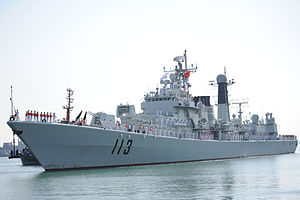
Back Torpédoborec typu 052 Czech Destructor Tipo 052 Spanish Classe Luhu Italian 旅滬型駆逐艦 Japanese Pembinasa Type 052 Malay Luhu-klasse Dutch Niszczyciele rakietowe typu 052 Polish Эскадренные миноносцы типа 052 Russian Type 052 (lớp tàu khu trục) Vietnamese 052型导弹驱逐舰 Chinese
 Qingdao at Haifa port, Israel in 2012
| |
| Class overview | |
|---|---|
| Builders | Jiangnan Shipyard |
| Operators | |
| Preceded by | Type 051 |
| Succeeded by | Type 051B |
| Built | 1990 – 1996 |
| In service | 1994 – present |
| Completed | 2 |
| Active | 2 |
| General characteristics | |
| Type | Guided-missile destroyer |
| Displacement | 4,674 tons[1] |
| Length | 144 m (472 ft 5 in)[1] |
| Beam | 16 m (52 ft 6 in)[1] |
| Draught | 5.1 m (16 ft 9 in)[1] |
| Propulsion | |
| Speed | 31 kn (57 km/h; 36 mph)[1] |
| Range | 5,000 nmi (9,300 km; 5,800 mi) at 15 kn[1] |
| Complement | 266[1] |
| Sensors and processing systems | |
| Electronic warfare & decoys | |
| Armament | |
| Aircraft carried | 2 helicopters: Harbin Z-9C[1] |
| Aviation facilities | |
The Type 052 (NATO/OSD Luhu-class destroyer[3] is a class of destroyers developed in the People's Republic of China (PRC) for the People's Liberation Army Navy (PLAN). The Type 052 was an intermediate between the obsolescent Type 051[4] and the modern Type 052B destroyers.[5][6] They were the first PLAN destroyers powered by gas turbines,[6] and the first PLAN ships with modern combat direction systems (CDS).[4] They were also part of the first generation of PLAN warships armed with surface-to-air missiles in the form of the short-range Crotale (called HQ-7 in Chinese service.)[7]
The Type 052 used subsystems imported from the United States and the European Union. The embargo after the 1989 Tiananmen Square protests and massacre ended the supply of and support for those subsystems, limiting production to two ships[4] and likely affecting their operating efficiency due to system integration issues.[4] Afterward, China turned to Russia and Ukraine for technology.[8][5]
- ^ a b c d e f g h i j k l m n o p q r s t u v w x y z aa ab ac Cite error: The named reference
jfs_2015-2016was invoked but never defined (see the help page). - ^ Cite error: The named reference
collins-grubb_2008_36was invoked but never defined (see the help page). - ^ "China Equipment" (PDF). United States Navy Office of Naval Intelligence. February 2015. Retrieved 14 March 2022.
- ^ a b c d Kirchberger (2015): page 186
- ^ a b Kirchberger (2015): page 195
- ^ a b McDevitt (2017): page 57
- ^ Kirchberger (2015): page 231
- ^ Kirchberger (2015): page 143
© MMXXIII Rich X Search. We shall prevail. All rights reserved. Rich X Search